| |
76
This elasticity of historical time may also be observed in the representations of the large plan itself. A careful examination of this plan reveals that the project of the Campo Marzio anticipates its condition as ruin. This applies equally to a formal strategy that encodes the passage of time in the collisive juxtaposition occurring in the city when a site is continually built over as it does to the representation itself. The only devise capable of resolving the ambiguities in the plan cut (sometimes a roof plan, at others a cellar or foundation) is the representation of ruins. And this is a third clue; like a primitive X-ray, the representation in ruins actually clarifies the structure, its previous history, the traces of its past occupation and transformations.
At this point, the reference to the well-known passage from Civilization and its Discontents cited at the beginning of this sections becomes clear. Freud and Piranesi have each radicalized a condition existing in Rome itself; the selective persistence of traces and fragments of the past continually juxtaposed with the process of decay and deterioration into a paradigmatic formal method. This is consistent throughout his work, and the systematic nature of this transformation distinguishes it from a picturesque romanticism. For Freud, the persistence of memory traces is the key to using the metaphor of the city. Yet the impossibility, in physical terms, of the
77
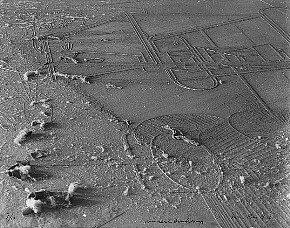
6. Man Ray, Dust Breeding, 1920. Photograph of Marcel Duchamp's The Bride Stripped Bare by Her Bachelors, Even signed by Man Ray and Duchamp.
scene he describes suggests another reading: the architecture of the city, too, is subject to amnesia and displacement. But, paradoxically, for Piranesi, this is precisely how the negative of history and the city may return as a positive value for an architectural culture "condemned to operate with degraded means."11
Finally, then: campo, a plane, a (battle)field; pianura, a level ground. But also tabula, a table or tablet. This is how Piranesi represents the plan of the Campo Marzio--as a rough stone tablet, clamped to the wall with heavy brackets, worn and cracked at the edges. The figure of the plan show no respect to the edges of the tablet. They are cut arbitrarily, not framed. The dedication is rendered as another tablet casually covering a portion of the plan. The entire image as an aroma of the archaic, a simulated antiquity. Like the glass surface of Duchamp's Large Glass in the photograph by Man Ray entitled Dust Breeding, it is a neutral screen that collects the deposits of age.12 As in this work signed by Duchamp and Man Ray, time is given an autonomous value. It both obscures form, through accumulation and deterioration, and creates new formal conditions. And these new conditions are uncontrollable--open to chance and free play.
Here Piranesi confronts another paradox, and in so doing anticipates certain modernist preoccupations. In the Campo Marzio, he is the author of that which has no single author. In the city, time is represented by the accumulation and its decay and transformation; this is why Piranesi takes pains to represent himself as the recorder, and not the inventor, of the form of the Campo Marzio. The internal consistency of a work authored all at once is absent, by necessity. Two options emerge simultaneously: the autonomy of the discipline, a set of intrinsic, self-referential rules that would supersede the subjectivity of a single author, and its inverse corollary, the uncontrolled play of chance and contingency.13
Michel Foucault has noted the way in which the figure of the table can simultaneously stand for the rule of order and the realm of free play:
I use that word 'table' in two superimposed senses: the nickel-plated, rubbery table swathed in white, glittering beneath a glass sun devouring all shadows--the table where, for an instant, perhaps forever, the umbrella encounters the sewing-machine; and also a table, a tabula, that enables thought to operate upon the entities of our world, to put them in order, to divide them in classes, to group them according to the names that designate their similarities and their differences--the table upon which, since the beginning of time, language has intersected space.14
It is this copresence of the scientific (geometrical and archaeological) and the ludic that makes Piranesi's project resonant in this century. The same site that authorizes Piranesi's "lawless" combinations also authorizes the cross-historical comparisons that would place Piranesi side by side with Duchamp, Man Ray, or Roussel.
On the other hand, by locating Piranesi's innovations in precise historical terms, Tafuri has shown that this "equilibrium of opposites" has a political dimension as well. To dissolve the opposition of reason and subjectivity constitutes an appropriation of power through the consolidation of technical control. This gives innovation itself an ideological role: "The 'power' will be that of the new techniques--unnamed but lying underneath like repressed demands--capable of controlling the forces that elude the eighteenth-century philosophe."15
11Tafuri, Architecture and Utopia, 16.
12ManRay has described this photograph as follows: "In the far corner near a window stood a pair of trestles on which lay a large piece of heavy glass covered with intricate patterns laid out in fine lead wires. It was Duchamp's major opus" The Bride Stripped Bare by Her Bachelors, Even. . . . I suggested to Duchamp that I pick up my camera, which I had never taken out of my place and photograph his glass. . . . Looking down on the work as I focused the camera, it appeared like some strange landscape from a bird's-eye view. There was dust on the work and bits of tissue and cotton wadding that had been used to clean up the finished parts, adding to the mystery. This, I thought, was indeed the domain of Duchamp. . . . Since it was to be a long exposure, I opened the shutter and we went out to eat something, returning about an hour later, when I closed the shutter. I hurried back to my basement and developed the plate--I always did my developing at night, not having a darkroom. The negative was perfect." (Man Ray, Self-Portrait (New York: Little Brown, 1963); cited in Man Ray: The Photographic Image, ed. Janus and trans. Murtha Baca [Woodbury, N.Y.: Barron's, 1980], 180).
13Peter Bürger has noted this convergence of seemingly opposed principles in twentieth-century avant-garde work, citing Adorno (Aesthetic Theory) to the effect that "the progress of art as making is accompanied by the tendency toward total arbitrariness. ...The convergence of the technical integral, wholly made work of art with one that is absolute chance has been noted with good reason." (Bürger, Theory of the Avant-Garde, trans. Michael Shaw [Minneapolis: University of Minnesota Press, 1984]).
14Michel Foucault, The Order of Things: An Archaeology of the Human Sciences (New York: Pantheon, 1973), xvii. Foucault reefers here to Raymond Roussel: in a work such as Roussel's Locus Solus, the neutral (narrative) field supports a series of episodic fragments of intense individuality, each one drawn and described in minute detail, barely held together by the ground they share. A further comparison is suggested by Leo Steinberg's use of the term "flatbed picture plane" to describe a change in the conception of the picture plane in American art of the 1950s. He notes that the picture plane no longer refers to a window opening out onto the world but rather to an all-purpose surface, a screen, upon which may be deposited any manner of material of the world--actual or representational: "The flatbed picture plane makes its symbolic allusion to hard surfaces such as tabletops, studio floors, charts, bulletin boards--any receptor surface on which objects are scattered, on which data is entered, on which information may be received, printed, impressed--whether coherently or in confusion." By referring to the flatbed printing press, Steinberg signals that it is the horizontality of this surface that is crucial: "no longer an analogue of a world perceived from an upright position, but a matrix of information conveniently placed in a vertical situation" (Steinberg, "Other Criteria," in Other Criteria: Confrontations with Twentieth-Century Art [Oxford: Oxford University Press, 1972], 82ff.).
15Tafuri, The Sphere and the Labyrinth, 30. Tafuri's remark, and his broader project of characterizing Piranesi's relationship to enlightenment thought under the notion of "negative utopia" (including his ambivalent relationship to the "authority" of classical architecture), might be contextualized by comparing it to the following passage from Max Horkheimer and Theodor Adorno: " For subjectivity, reason is the chemical agent which absorbs the individual substance of things and volatilizes them in the mere autonomy of reason. In order to escape the superficial fear of nature, it wholly transformed objective entities and forms into the mere veils of a chaotic matter, and anathematized their influence on humanity as slavery, until the ideal form of the subject was no more than unique, unrestricted, though vacuous authority" (Horkheimer and Adorno, Dialectic of Enlightenment, trans. John Cumming [1944; New York: Herder & Herder, 1987], 89-90).
| |
2013.12.29
Bilocational Contingency
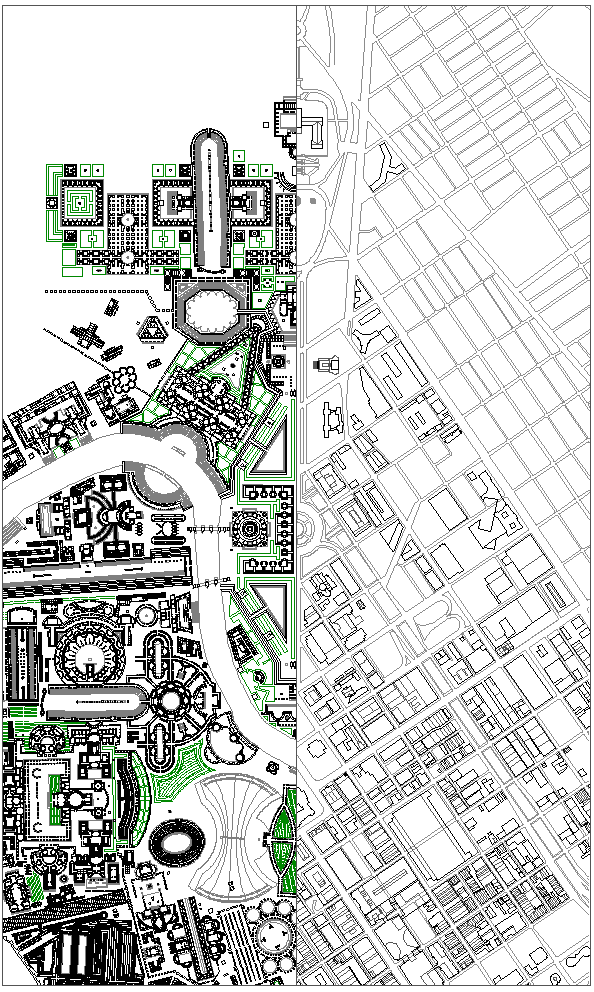
Philadelphia's Benjamin Franklin Parkway matches exactly the long axis of Piranesi's Ichnographia Campus Martius, with the Philadelphia Museum of Art at one end matching the Nympheum Neronis, Logan Circle at the middle of the Parkway matches Hadrian's Tomb, and the tiny intercourse building at the other end matches the location of the Robert Indiana LOVE sculpture at the entrance to JFK Plaza.
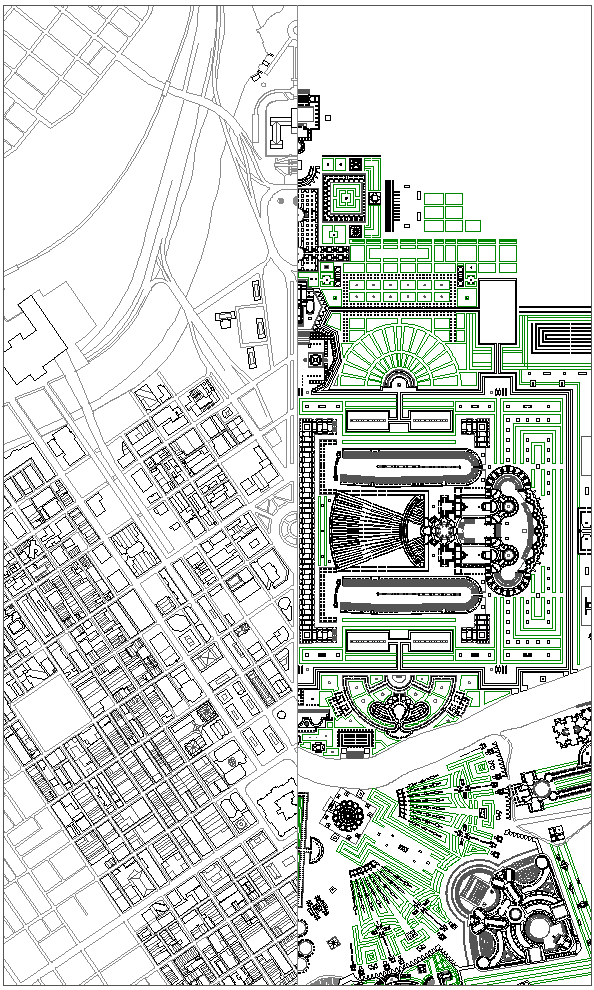
Much of Piranesi's Campo Marzio plan is of his own design, albeit based on a retelling of Rome's (architectural) history. The exacting relation in scale and pattern between the long axis of the Campo Marzio and Philadelphia's Benj. Franklin Parkway offers a real opportunity to step into Piranesi's otherwise virtual Roman world.
The Bride Stripped bare by Her Bachelors, Even
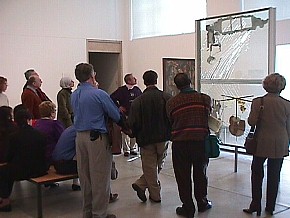 is on permanent display at the Philadelphia Museum of Art, and immediately above the Large Glass is the Drawing Room of Lansdowne House,
is on permanent display at the Philadelphia Museum of Art, and immediately above the Large Glass is the Drawing Room of Lansdowne House,
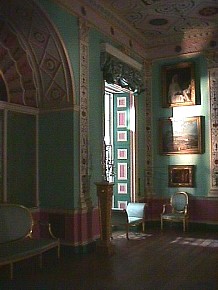 by Robert Adam, to whom the Ichnographia Campus Martius is dedicated.
by Robert Adam, to whom the Ichnographia Campus Martius is dedicated.
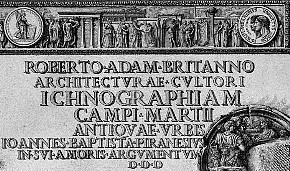 And at the other end of the axis, Robert Indiana's LOVE
And at the other end of the axis, Robert Indiana's LOVE
 coincides with the Campo Marzio's
coincides with the Campo Marzio's
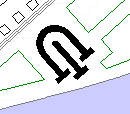 'Aedicula Intercourse,' which bears a strong resemblance to Venturi and Rauch with Scott Brown's Fairmount Park Fountain Competition
'Aedicula Intercourse,' which bears a strong resemblance to Venturi and Rauch with Scott Brown's Fairmount Park Fountain Competition
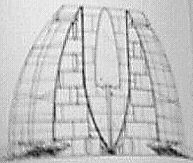 designed for the same site.
designed for the same site.
"Here we have an enormous egg, cracked open by a very long diagonal axis with a giant jet-stream gushing inside."
|